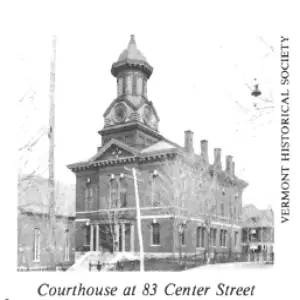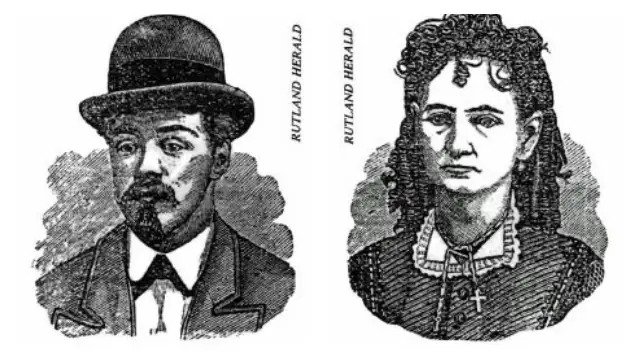On June 9, 1874, a devastating fire consumed a two-story house in Rutland, Vermont, known locally as the “swamp.” The charred remains of Mrs. Ann E. Freese, a 47-year-old widow, were discovered among the ashes. Tragically, she had been stabbed in the throat before the fire ignited. The search for her killer would prove to be a complex and challenging task.
The Fire and Discovery
Around 6:45 a.m., neighbors noticed smoke billowing from the second floor and quickly raised the alarm. They knew Mrs. Freese was inside, but the front door was locked, and the flames spread rapidly. By the time firefighters arrived, it was too late to save either the house or Mrs. Freese. Her remains were later examined, revealing that she had been brutally stabbed four times in the throat. A razor found nearby was suspected to be the murder weapon.
Mrs. Freese had built her home three years prior, following her husband Alvin’s death. The house was notorious in the community as a brothel, frequented by many men. This made identifying her killer particularly difficult. Adding to the confusion, Barnum’s circus was in town, and three circus employees became suspects. With no solid leads, the Rutland selectmen offered a $2,500 reward for information leading to the capture of the murderer.
The Prime Suspect: John Phair
The police quickly focused on John Phair, a local man with a troubled past. He had been seen with Mrs. Freese at the circus just days before the murder. Phair had checked into the Berwick House hotel but vanished the night before the fire, leaving his belongings behind. He boarded a train to Boston early Tuesday morning, raising suspicions about his involvement.
Phair had a history of crime, including a conviction for grand larceny at eighteen. After serving time, he had seemingly turned his life around, working as a machinist. He claimed he was in Providence, Rhode Island, looking for work on the day of the murder. However, the police were determined to investigate his alibi.
The Pawnshop Clue
Detectives traveled to Boston, searching for any of Mrs. Freese’s belongings that might have been pawned. They had a detailed description of her jewelry, including a watch with a unique serial number. At one pawnshop, they found her watch, which had been sold by a man named E. F. Smith. Witnesses identified Phair as the person who pawned the watch, leading to his arrest.
Phair was charged with murder, arson, and larceny. The evidence against him was circumstantial but compelling. The prosecution argued that the person who pawned the jewelry was likely the murderer. However, Phair’s defense team challenged the evidence, claiming it was unreliable and biased.

The Trial
The trial began on September 29, 1874. The defense argued that Phair could not have set the fire, as he had boarded a train at 4:00 a.m., hours before the fire was discovered. They also criticized the credibility of the pawnshop owners who identified him, suggesting their motives were questionable.
Despite the defense’s efforts, the jury deliberated for only four hours before returning a guilty verdict for first-degree murder. Phair was sentenced to hang on April 6, 1877.
The Dying Statement
As the execution date approached, Phair prepared a “dying statement,” proclaiming his innocence. He believed he was being unfairly judged due to his past. His statement was sold to the Boston Daily Globe for publication after his execution. However, news of his statement leaked, prompting the Globe to publish it the day before his hanging.
In his statement, Phair maintained that he had traveled to Providence for work and had not pawned any jewelry. He blamed the police and the pawnshop owners for his conviction.
A Last-Minute Reprieve
On the day of his scheduled execution, a businessman named M. D. Downing came forward with information that could exonerate Phair. He had met a man on a train who claimed to be from Rutland, looking for work. This prompted Downing to contact the governor, who issued a reprieve, delaying the execution for a week.
The Vermont legislature debated changing the law to allow Phair to request a new trial. Eventually, they passed a law permitting a new trial if two judges filed a petition. However, when the Supreme Court reviewed the case, they upheld the original verdict.
The Final Outcome
On April 10, 1879, John Phair was hanged at the State Prison in Windsor, Vermont. He maintained his innocence until the very end, insisting that he had been wrongfully convicted due to his past and the unreliable testimonies against him. His execution marked a tragic conclusion to a case filled with intrigue, suspicion, and unanswered questions.
The Legacy of the Case
The murder of Ann E. Freese and the subsequent trial of John Phair left a lasting impact on the Rutland community. The case highlighted the challenges law enforcement faced in solving crimes linked to illicit activities, such as those occurring in brothels. It also raised questions about the reliability of witness testimonies, especially when influenced by personal biases and societal prejudices.
Phair’s story became a cautionary tale about the consequences of a troubled past. Despite his claims of innocence, his history of crime made it easy for the public and the jury to view him as guilty. The case also underscored the importance of thorough investigations and the need for justice to be served fairly, regardless of a person’s background.
Reflection on Justice
In the years following the execution, discussions about the fairness of the legal system and the treatment of individuals with criminal histories gained traction. The case of Ann E. Freese and John Phair served as a reminder of the complexities involved in the pursuit of justice. It prompted many to advocate for reforms in the legal system, particularly regarding how past crimes could unfairly influence current cases.
Conclusion
The tragic events of June 9, 1874, remain etched in the history of Rutland, Vermont. The fire that claimed Ann E. Freese’s life and the subsequent trial of John Phair continue to evoke interest and debate. While Phair was convicted and executed, the lingering questions about his guilt and the circumstances surrounding the case remind us of the delicate balance between justice and the potential for wrongful convictions.
As we reflect on this dark chapter in history, it is essential to remember the human lives affected by these events. Ann E. Freese was more than just a victim; she was a woman with a story, and her tragic end serves as a poignant reminder of the complexities of human relationships and the often murky waters of morality and justice.
This case remains a significant part of Vermont’s history, illustrating the challenges of crime and punishment in a time when societal norms and values were vastly different from today. The story of Ann E. Freese and John Phair continues to resonate, reminding us of the importance of seeking truth and justice in every circumstance.

